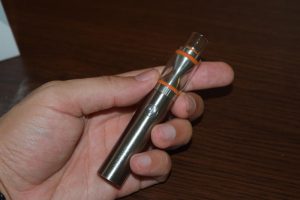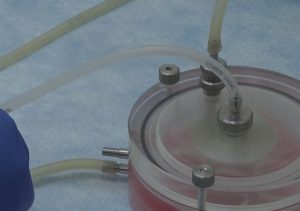Controversial Study on Mice Suggests Vaping Could Cause Cancer in Humans
Public health experts and tobacco researchers have long been saying that it’s not the nicotine that kills smokers, but the many other carcinogens contained by tobacco cigarettes. However, according to a recent study by researchers at New York University, the nicotine in electronic cigarette vapor can cause DNA damage and impair cells’ DNA repair mechanism, putting users at risk of developing cancer.
 Moon-shong Tang, professor of environmental medicine at New York University, and his team looked at how e-cigarette vapor affected the DNA of mice and lab-grown human cells. They exposed the mice to vapor for three hours a day, five days a week for a period of three months, using an automated three-port e-cigarette aerosol generator. This special machine used NJOY top-fill tanks filled with 1.6 mL of e-juice with 10 mg/mL nicotine in a propylene glycol/vegetable glycerin mixture(50/50 by volume; MtBakerVapor MESA). 4-second puffs were generated into the exposure room at 30-second intervals.
Moon-shong Tang, professor of environmental medicine at New York University, and his team looked at how e-cigarette vapor affected the DNA of mice and lab-grown human cells. They exposed the mice to vapor for three hours a day, five days a week for a period of three months, using an automated three-port e-cigarette aerosol generator. This special machine used NJOY top-fill tanks filled with 1.6 mL of e-juice with 10 mg/mL nicotine in a propylene glycol/vegetable glycerin mixture(50/50 by volume; MtBakerVapor MESA). 4-second puffs were generated into the exposure room at 30-second intervals.
After analyzing the data collected during the three-month study, researchers concluded that the exposure to nicotine-containing vapor caused DNA damage in the hearts, lungs and bladders of mice, and that the animals’ natural DNA repair mechanisms had also been suppressed. These sort of changes were not evident in a control group of mice that had breathed filtered air during the study.
Tang and his team then went on to expose lab-grown human lung and bladder cells to nicotine, and found that it caused the cells to mutate and turn into tumor tissue more easily. Apparently, the nicotine nitrosation process that occurs in the lung, bladder, and heart creates other DNA damaging agents – 4-(methylnitrosamine)-1-(3-pyridyl)-1-butanone.
“We propose that ECS (electronic cigarette smoke), through damaging DNA and inhibiting DNA repair, might contribute to human lung and bladder cancer as well as to heart disease, although further studies are required to substantiate this proposal,” the NYU researchers concluded.
The study was recently published in the journal “Proceedings of the National Academy of Sciences of the United States of America” and its ominous findings have already been heavily pushed my mainstream media, in an effort to undermine vaping.
This is certainly not the most encouraging study on vaping ever published, but I would definitely take its conclusions with a grain of salt. Let’s not forget that most studies into the effect of vaping on the human body have found that it poses no major risks and is orders of magnitude safer than smoking tobacco.
That’s one of the major gripes I have with this study, it doesn’t put things into perspective by comparing the effects of exposure to e-cigarette vapor to those of exposure to cigarette smoke. Vaping was never promoted as 100% safe, but as a considerably safer alternative to smoking. Even if the nicotine in the vapor does cause the kind of DNA damage Prof. Tang and his team claim it does, it would have been interesting to see how it compares to the damage caused by cigarette smoke.
And after reading one of Tang’s statements regarding the danger of vaping compared to smoking, I personally have serious doubts that he and his team simply omitted to also offer insights into the effects of cigarette smoke on DNA. Asked by Bloomberg what he would tell smokers considering making the switch to vaping, Prof. Tang apparently hesitated and then said “We don’t know which one is more harmful”.
Well, Prof. Tang, you just had the opportunity to find out how smoking stacks up against vaping, but apparently you passed on it. Instead, you’re more than comfortable making statements like the one above that could lead many people to believe that vaping is just as bad as smoking, if not worse. Let’s not forget that tobacco cigarettes contain not just the nicotine, but also dozens of known carcinogens, as well as thousands of compounds the effects of which on human health are currently unknown.
Moon-shong Tang also told Bloomberg that the data he and his team recorded during the study points to the “almost unambiguous” conclusion that nicotine can be converted into carcinogens inside the human body. There’s just one problem with that, his research didn’t involve any humans, or even vaping in real-life conditions, for that matter.
As Cancer Research UK notes in a response to the controversial study, “Researchers from New York University School of Medicine looked at how e-cigarette vapor affected the DNA of mice, and human cells in a dish. They didn’t look at how it affected people. And they didn’t directly compare it to smoking.”
“The researchers focused on how components of e-cig vapor damage cells’ DNA. And DNA damage increases the risk of cancer. But they didn’t look directly at whether e-cigs caused cancer, either in mice or in people,” the CRU response states.
In fact, the official conclusion of the NYU study is: “It is therefore possible that e-cigarette smoke may contribute to lung and bladder cancer, as well as heart disease, in humans.”
I’m no linguist, but ‘possible’ sounds very different than ‘almost unambiguous’.
While some researchers view the study as important, to others it just more misinformation used to discourage people from quitting smoking and switching to what is generally considered a less dangerous alternative.
“This study shows nothing at all about the dangers of vaping. It doesn’t show that vaping causes cancer,” Peter Hajek, director of the Tobacco Dependence Research Unit at Queen Mary University of London, told The Guardian. “This is one in a long line of false alarms which may be putting people off the switch from smoking to vaping which would undoubtedly be of great benefit to them. The best current estimate is that vaping poses, at worst, some 5% of risks of smoking.”
Now, I can’t comment too much about the methodology used by Prof. Tang and his team, as the technical language in the study is hard to decipher, but one thing that caught my eye was the voltage used by the vaping machine to generate vapor. NJOY specifically states that its tanks are not to be used with batteries that operate at more than 3.7V. However, the Tang study clearly states that the machine they were using was set to 4.2V. Any knowledgeable vaper will tell you that 0.5V is more than enough to turn an enjoyable puff into what is known as a ‘dry hit’ (burning the cotton wick).
I don’t know if this particular detail could have influenced the results of the research or not, but it does once again raise the question if otherwise perfectly qualified researchers posses enough knowledge about vaping to carry out this sort of experiments. Let’s not forget that study where scientists generated enough power to completely char the cotton wicking of an atomizer, and concluded that e-cigarettes produce more formaldehyde than tobacco cigarettes. In that particular case, they had, but they certainly don’t when used properly.
I for one am still waiting to hear the responses of other researchers with some experience in regards to vaping. People like Dr. Konstantinos Farsalinos or Michael Siegel could definitely shed some light on this issue.
















